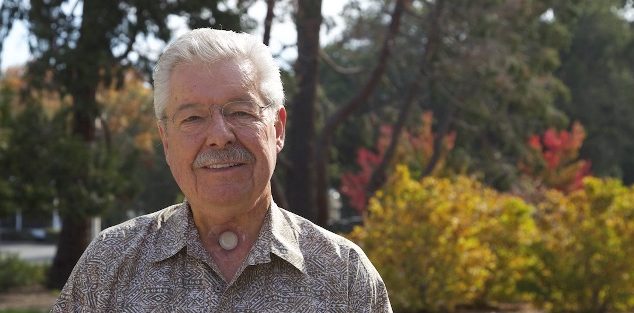News
Emotions soar at stem cell board meeting
 Throat cancer patient Karl Trede, who was treated with the "eat me" protein therapy. (Photo: California Institute for Regenerative Medicine)
Throat cancer patient Karl Trede, who was treated with the "eat me" protein therapy. (Photo: California Institute for Regenerative Medicine)In an emotion-choked session, the mother of a six-year-old girl thanked California’s stem cell agency for saving the life of her daughter.
“Thank you for keeping my family complete,” said Alysia Padilla-Vaccaro, her voice cracking as she spoke Tuesday to the governing board of the $3 billion California Institute for Regenerative Medicine (CIRM), as the agency is formally known.
“My experience has truly been life-changing … I hope you continue to push the boundaries and help as many people as you can.” — Brenden Whittaker, 22.
Her daughter, Evangelina, also whispered a soft “thank you”to the board and CIRM staff at the Oakland meeting. She had suffered from what is known as the “bubble baby syndrome.”
Evangelina was one of two persons cured by treatments developed with the help of financing from the stem cell agency, created by voters in 2004 and supported by state bonds.
Brenden Whittaker, 22, was the second person. He was near death twice and lost parts of his lungs and liver as the result of another, rare, immune deficiency disease.
“My experience has truly been life-changing … I hope you continue to push the boundaries and help as many people as you can,” Whittaker said.
The stem cell agency estimates it has $692 million left for new awards between now and 2020, when it expects to run out of cash.
Randy Mills, president of the agency, presented Whittaker and Evangelina to the board during a review of the progress of the agency. He said they were “the first two patients to be cured by CIRM programs.” Mills also introduced two other patients who have been helped by the agency’s research: Jake Javier, who suffered a paralyzing spinal cord injury, and Karl Trede, a cancer patient. The agency has not developed a therapy for widespread use.
Mills hailed their courage and the courage of their families for taking part in the risky clinical trials. Mills told the 29-member CIRM board that in pursuit of stem cell cures that the agency had to be “Jake-strong,” a term originating with Javier’s mother after his injury.
The stem cell agency estimates it has $692 million left for new awards between now and 2020, when it expects to run out of cash. The research budget for next year was approved at $328 million with most of it going for clinical programs. Clinical trials represent the last stage for a proposed therapy before it reaches the market.
The CIRM board has approved a goal of 40 more clinical trials between now and 2020. Currently it has 22 underway. Only one out of 10 conventional treatments that begin trials wind up as commercial products. Often the trial process can take many years even with conventional therapies. No stem cell treatments have yet been approved by the Food and Drug Administration in this country.
Here is more on the patients featured at today’s meeting:
Evangelina, of Corona, Ca., was diagnosed shortly after birth with “bubble baby” disease and no functioning immune system. Her blood cells were genetically altered to create a new blood and immune system. The therapy was developed by Donald Kohn of UCLA. CIRM has backed his work, which goes beyond the bubble baby affliction, with nearly $52 million. (See here, here and here.)
Whittaker, of Columbus, Ohio, almost died twice as a result of a rare immune system disease. Parts of his lung and liver were removed due to repeated infection. His blood stem cells were genetically modified to create a new blood system and a healthy immune system. The treatment was also developed by Kohn at UCLA.
Javier, 19, of San Ramon, Ca., was paralyzed as the result of a swimming pool accident. He received 10 million stem cells,the first person to have such an injection, and has since regained the use of his arms. His treatment grew out of the trial that Geron Corp. abandoned in 2011. Asterias Therapeutics of Menlo Park, Ca., has continued the work. Between the two companies, CIRM has invested nearly $21 million in the project. Jane Lebkowski has led the research at both companies.
Trede, 70, of San Jose, Ca., lost his vocal cords, removed because of cancer of the throat. The cancer nonetheless spread but was treated with the “eat me” protein therapy from Stanford University. As a result, his cancer has stopped growing. CIRM invested $40 million in the project, initiated by Irv Weissman of Stanford, who developed the CD47 treatment. It has led to the formation of a new company in Palo Alto called Forty Seven, Inc.
(See here for a CIRM item on Trede. For the text of CIRM summaries on the four, see here.)
—
Ed’s Note: David Jensen is a retired newsman who has followed the affairs of the $3 billion California stem cell agency since 2005 via his blog, the California Stem Cell Report, where this story first appeared. He has published more than 4,000 items on California stem cell matters in the past 11 years.
Want to see more stories like this? Sign up for The Roundup, the free daily newsletter about California politics from the editors of Capitol Weekly. Stay up to date on the news you need to know.
Sign up below, then look for a confirmation email in your inbox.

The article did not share where the source of these stem cells were for these clincal efforts achieved. The cost of this work should have been mentioned, as it is unclear what having $682 Million left before it runs out of cash means. In relation to what original funding amount?